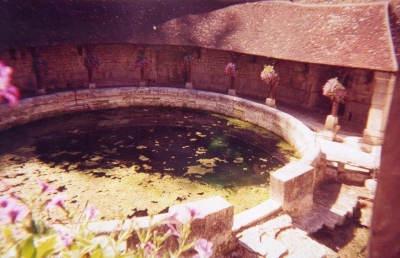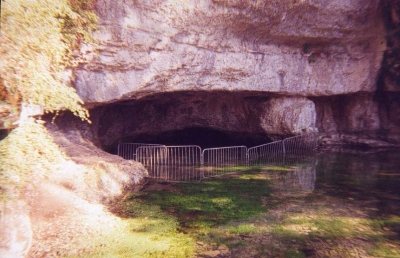 First
stop (due to a sight navigation error... you would think that a thick marker
pen line would be easy to follow on a map) was the town of Tonerre. This
is an ancient settlement, dating back to Gaulish times where the town's
spring was a source of veneration. It was also a sacred spring to the invading
Romans and legends abounded about white knights facing the devil, treasure
troves and even today, a serpent is said to inhabit it. The spring, the
Fosse Dionne (the Spring of Yonne) has in fact claimed the lives of a number
of divers. The cynical may say this is due to the depth (60m+), the cold
and the narrow restrictions but many of the locals will attribute the accidents
to the serpent. Francis le Guen has carried out considerable exploratory
work here and the site is currently closed due to its archaeological interest. First
stop (due to a sight navigation error... you would think that a thick marker
pen line would be easy to follow on a map) was the town of Tonerre. This
is an ancient settlement, dating back to Gaulish times where the town's
spring was a source of veneration. It was also a sacred spring to the invading
Romans and legends abounded about white knights facing the devil, treasure
troves and even today, a serpent is said to inhabit it. The spring, the
Fosse Dionne (the Spring of Yonne) has in fact claimed the lives of a number
of divers. The cynical may say this is due to the depth (60m+), the cold
and the narrow restrictions but many of the locals will attribute the accidents
to the serpent. Francis le Guen has carried out considerable exploratory
work here and the site is currently closed due to its archaeological interest. |
Introduction
Cote d'Or Jura Switzerland Order Book |
 Next
stop was to drive east towards the town of Chatillon-sur-Seine, a small
market town, which again dates back to Gaulish times. The local museum
contains a reproduction of the tomb of a Gaulish princess that was found
a few years ago, filled to the roof with gold. Like Tonerre, the town has
its own spring that has been a site of veneration too. The Douix de Chatillon
is a resurgence at the bottom of a small cliff in a town park and for centuries
the local Gauls have chucked offerings into it, especially small oil lamps.
Today the local Gauls use the spring as a source of mineral water, collecting
it in plastic bottles. It is also used by cave divers as a training site
due to its excellent conditions (extremely clear and very shallow) and
has had a steel chain bolted to the wall rather than a regular guide line.
However the cave should not be overlooked as it has great potential once
the terminal choke has been passed. The cave can be seen here with a steel
barrier across the entrance. The Gendarmerie refused to explain other than
to say "fermez", I found out later it was to prevent children wandering
into the cave during low water conditions. It was a shame as the cave is
very impressive. Next
stop was to drive east towards the town of Chatillon-sur-Seine, a small
market town, which again dates back to Gaulish times. The local museum
contains a reproduction of the tomb of a Gaulish princess that was found
a few years ago, filled to the roof with gold. Like Tonerre, the town has
its own spring that has been a site of veneration too. The Douix de Chatillon
is a resurgence at the bottom of a small cliff in a town park and for centuries
the local Gauls have chucked offerings into it, especially small oil lamps.
Today the local Gauls use the spring as a source of mineral water, collecting
it in plastic bottles. It is also used by cave divers as a training site
due to its excellent conditions (extremely clear and very shallow) and
has had a steel chain bolted to the wall rather than a regular guide line.
However the cave should not be overlooked as it has great potential once
the terminal choke has been passed. The cave can be seen here with a steel
barrier across the entrance. The Gendarmerie refused to explain other than
to say "fermez", I found out later it was to prevent children wandering
into the cave during low water conditions. It was a shame as the cave is
very impressive. |
|
 Last
stop of the day was to be the Source de Beze, the resurgence for the Grotte
de la Cretanne show cave in the town of Beze. Water levels were very low
and there was very little flow. The cave is one of the most impressive
in France, the passage is huge and filled with boulders the size of small
buses and eventually it surfaces in an underground lagoon where the showcave
moors its tour boats. Next day we went in search of Creux Janin, a spring
a little way to the north. The entrance to the cave is a small stagnant
looking pool at the bottom of a dusty valley, visibility was less than
a metre and once the entrance restriction is passed the cave is more comfortable
and goes for about 1700m. Last
stop of the day was to be the Source de Beze, the resurgence for the Grotte
de la Cretanne show cave in the town of Beze. Water levels were very low
and there was very little flow. The cave is one of the most impressive
in France, the passage is huge and filled with boulders the size of small
buses and eventually it surfaces in an underground lagoon where the showcave
moors its tour boats. Next day we went in search of Creux Janin, a spring
a little way to the north. The entrance to the cave is a small stagnant
looking pool at the bottom of a dusty valley, visibility was less than
a metre and once the entrance restriction is passed the cave is more comfortable
and goes for about 1700m. |